How to Free Up Drive Space on Windows 10

Windows 10 enables the users to manage disk space on their devices. Today, the PC and laptops are coming with an enhanced storage capacity ranging from the Gigabytes to Terabytes. These storage sections are known as Hard Disk Drive (HDD), and the same is used to store all your device data, files, images, videos, website contents, etc. Have you ever wondered what will happen if these storage disks are full, what will you do? Don’t worry; we have the solution. You have to free up your system disk space by removing unwanted materials, applications, or files. There are two reasons for this task:
- It enhances your system speed
- It provides more space for your data to store
These disks can be freed by scanning all your system stores or Hard Disk drive. If you want to free up more and more space on your device, then follow these instructions carefully:
- Managing the Device Storage to free up More Space
There are various ways to free up more and more disk capacity for other tasks. It can be done by managing the storage sections such as cloud storage, software, reducing the size of the local file, etc.
- Removing Temporary Files
Temporary files contain junk that is not necessary for your use, and it is created by a third party or Windows resource tools and programs. These are waste materials that consume lots of space on your HDD. If that’s the case, it is recommended to remove them from your device.
They can corrupt your disk space if you don’t remove them from your device. It is advised to purge all the unwanted data and make all your files temporary for quick removal out from your hard drive. To remove these temporary files, you have to navigate to the storage settings of Windows 10 that will give a clean and fresh disk environment for your Hard Disk. To remove them from your device, follow these guidelines:
- First and foremost, launch the Storage settings on your device by typing the keywords “storage” into the Windows search panel.
- Now, choose the storage option and expand the save location options of your Settings application there.
- Now, tap on “This PC (C:)” option to launch the HDD storage overview.
- Then, this overview displays you the entire HDD storage bar and also shows you the leftover space on your device. The section provides detailed data of all the memory and space consumption by various applications, programs, music, files, images, audio, video mails, documents, and temp files.
- Now, click on the option “Temporary Files” and then navigate to the Remove Files option there.
- After you have selected the Temporary files, you need to mark the temporary files mark box.
- Then, hit the Remove files tab there. This action will delete all the available junks on your hard disk. You may choose the checkmark option Download Folder that will help you to delete downloaded files from your device.
- Sometimes, software or program installers also consume more space on your disk and make the disk of no use. In this case, firstly, you have to check that these installers are of no use there as you have already installed the application. In this case, you have to remove installation files there with the “Cyber D’s Autodelete” feature.
- It is also directed to mark the box related to an Empty Recycle bin or trash. This action will remove all the existing files located on your Recycle Bin.
- Remove Files through Cloud Storage
Nowadays, online file storage and saving are in trend, and it is advised to save all your data, documents, images, music, video, etc. on any of the reliable Cloud applications. There are several online storage services such as Google Drive, Dropbox, OneDrive, etc. they provide seamless services for storing the data with enhanced security. If you are much concerned about the security of your data, then you may set up a password for your Cloud accounts.
Most Windows 10 users store their data on OneDrive as it’s a segment of the Office 365 subscription package. These Cloud devices provide unmatched services far better than saving your file locally on your device. Saving files in the local drive are more vulnerable to cyber threats and malicious content. This cloud-based service provides most of the services for free, but if you even want to take a premier subscription, you have to pay for the same. These drives take the nominal fee as per your standard and subscription package.
One can use other services like file compressor or CCleaner for removing and squeezing the file size to free up extra space. You can use various third party applications for removing applications and managing space storage on disks.
Source - How to Free Up Drive Space on Windows 10
Post Your Ad Here
Comments